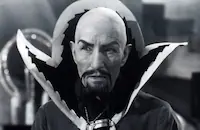Men of San Quentin
Cast & Crew
William Beaudine
J. Anthony Hughes
Eleanor Stewart
Dick Curtis
Charles Middleton
Jeffrey Sayre
Film Details
Technical Specs

Synopsis
Jack Holden returns from his honeymoon with his wife Anne and resumes his job as a guard at San Quentin prison, in San Francisco. When three inmates, including Butch Mason and Big Al, are sent to one of the guards' residential cottages to work on the plumbing, they take their guard, Gaines, hostage and attempt to escape. After one of the inmates is killed, Butch, a brutal and desperate convict, kills Gaines and the remaining inmate. Jack captures Butch, who then claims that he never fired a shot. When the governor orders an inquiry, Warden Saunderson bribes one of his men to say that he heard Jack order Gaines to shoot the inmates. Saunderson then places Jimmie, a prisoner who hopes to reform and lead a normal life, as a houseboy in the Holden cottage to eavesdrop. Saunderson also makes a deal with Butch, who is in solitary confinement, to free him from solitary if he will say he was covering for Jack. After Butch is released, he intimidates Jimmie into burying a gun in Jack's garden to use in another escape attempt. Although Butch signs an affidavit saying that Jack killed Gaines, his fear of retribution makes him change his story and admit to being the killer. Jimmie digs up the gun as planned, but, as Anne has been kind to him, he tells her that Saunderson is trying to frame Jack. Saunderson gets angry when none of the inmates will testify at the inquiry because Anne's friend, reporter Joe Williams, has already published a report about Jimmie's friend Louis being framed for another guard's murder. Jimmie, having lost all hope for reform, shoots Saunderson in Anne and Jack's house, and then commits suicide. The prison board nominates Jack to replace Saunderson, and asks Joe to report on their attempts to effect prison reform. Jack, who believes that "confinement is sufficient punishment," institutes a plan to restore the inmates' self-respect via rehabilitation. After dismantling the solitary confinement cells and freeing Louis, Jack asks inmate Skins Miller to organize a musical show, and creates classes for the inmates. One day, Anne and Joe listen in on the speakers in each classroom, and overhear Big Al intimidating Louis into helping them with their planned jailbreak. Jack goes to Louis' defense and confronts Big Al, from whom he wrests a gun. Louis is finally released and starts his new life with recently learned skills. At the same time, a prison variety show is broadcast over the radio. Jack hopes the broadcast will educate the public about the existence of thousands of inmates who, like Louis, are trying to make good.

Director
William Beaudine
Cast
J. Anthony Hughes
Eleanor Stewart
Dick Curtis

Charles Middleton
Jeffrey Sayre
George Breakston
Art Miles
Michael Mark
John Ince
Joe Whitehead
Skins Miller
Jack Shay
Jack Cheatham
Drew Demarest
Rita Douglas
John A. Hendricks
G. Rolph Burr
Jack Reavis
William Cowley
Nancy Evans
Crew
George R. Batcheller
Ernest Booth
Con Conrad
Benny Davis
Dwight A. Greene
Carl C. Hocker
Max M. King
Dick L'estrange
Martin Mooney
Martin Mooney
Clark Ramsay
David T. Shaw
Ted R. Stanich
J. R. Thomas
Ben Winkler

Film Details
Technical Specs

Quotes
Trivia
Notes
The opening credits include the following written dedication: "This picture is dedicated to Warden Clinton T. Duffy and the Men of San Quentin." According to a New York Times news item, the character of "Jack Holden" was based on Duffy. The following written foreword appears onscreen after the opening credits: "In 1851 California became a State and discovered she needed a prison for the punishment of outlaws who swarmed to her in the Gold Rush. A low building was erected on a bleak point of San Francisco Bay-and thus San Quentin Prison started its bloody history. Riots, escapes and murders were frequent. Our story opens with the fearful tranquility that follows the slaying of a guard. Solitary cells are jammed with inmates, the guards restless and a political upheaval is impending."
According to a New York Times news item, producers obtained signed releases from all prisoners "recognizable" in the film, including "Rolph G. Burr, announcer and writer of the prison radio program," who was to be paroled shortly after production "to take a job with the Mutual Broadcasting System." This film was shot in part on location at San Quentin Penitentiary in CA. According to the Motion Picture Herald review, the film's "first public showing was held...in San Quentin's mess hall where 300 convicts sat with members of the press who made the trek from Hollywood to San Francisco."












